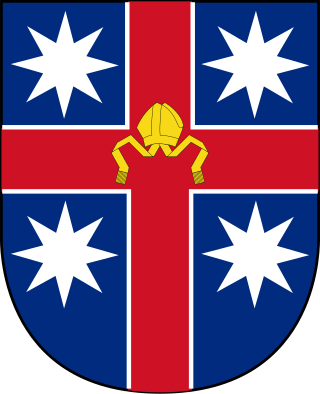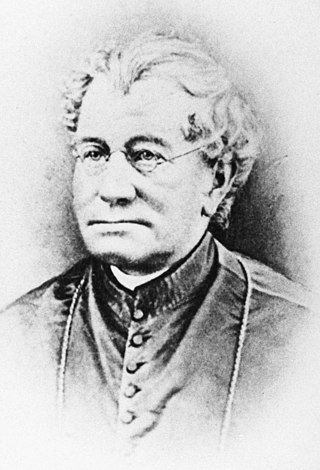
The Anglican Church of Australia, formerly known as the Church of England in Australia and Tasmania, is a Christian church in Australia and an autonomous church of the Anglican Communion. It is the second largest church in Australia after the Catholic Church. According to the 2016 census, 3.1 million Australians identify as Anglicans. As of 2016, the Anglican Church of Australia had more than 3 million nominal members and 437,880 active baptised members. For much of Australian history since the arrival of the 'First Fleet' in January 1788, the church was the largest religious denomination. It remains today one of the largest providers of social welfare services in Australia.

The Catholic Church in Australia is part of the worldwide Catholic Church under the spiritual and administrative leadership of the Holy See. From origins as a suppressed, mainly Irish minority in early colonial times, the church has grown to be the largest Christian denomination in Australia, with a culturally diverse membership of around 5,075,907 people, representing about 20% of the overall population of Australia according to the 2021 ABS Census data.

The Cathedral Church and Minor Basilica of the Immaculate Mother of God, Help of Christians is the cathedral church of the Roman Catholic Archdiocese of Sydney and the seat of the Archbishop of Sydney, currently Anthony Fisher OP. It is dedicated to the "Immaculate Mother of God, Help of Christians", Patroness of Australia and holds the title and dignity of a minor basilica, bestowed upon it by Pope Pius XI on 4 August 1932.

William Bernard Ullathorne was an English prelate who held high offices in the Roman Catholic Church during the nineteenth century.

James Alipius Goold was an Australian Augustinian friar and the founding Catholic Archbishop of Melbourne in Australia.

Sir Roger Therry was an Irish-Australian jurist and member of the New South Wales Legislative Council.
The following lists events that happened during 1820 in Australia.
The following lists events that happened during 1821 in Australia.

Bishop Francis Murphy was an Irish-born Roman Catholic priest and first Catholic Bishop of Adelaide, South Australia.
Henry Fulton was a Church of Ireland curate who, as a United Irishman in 1798, was transported to New South Wales where in the Rum Rebellion, and the subsequent inquiries, he took the part of Governor William Bligh.
Robert William Willson was an English Roman Catholic bishop, the first Bishop of Hobart, and an advocate for the convicts in Australia.
Thomas Hobbes Scott was an English-born Anglican cleric active in the Colony of New South Wales.
Patrick Bonaventure Geoghegan, O.F.M. (1805–1864) was an Irish Roman Catholic clergyman who served firstly as Bishop of Adelaide. Born in Dublin, he became a Franciscan friar and served at a Dublin parish before volunteering for Australia. After five years as Bishop of Adelaide, He returned to Ireland, intending to stay only briefly. He was named Bishop of Goulburn, Australia, but died before he could assume the post.
John Brady, an Australian metropolitan bishop, was the first Roman Catholic Bishop of Perth, serving from 1845 until his death in 1871, despite having been suspended of his functions motu proprio in October 1851 by Pope Pius IX.
James Dempsey, transported from Ireland following the 1798 rebellion, was the founder of the first Roman Catholic community in Australia and was a major contributor to the building of the first Catholic cathedral in Australia.
Janus was launched at New York in 1810. Between 1819 and 1820 she transported female convicts to Port Jackson. Thereafter, she went on a whaling voyage. She later spent some years sailing between Falmouth and Quebec, and was last listed in 1832.

St Anne's Roman Catholic Church is a heritage-listed Roman Catholic school and church building located at St Annes Square, Strathfield South in the Municipality of Strathfield local government area in Sydney, New South Wales, Australia. It was built from 1859 to 1864. It is also known as St. Anne's Roman Catholic Church (former) and St Anne's Catholic Church. It was added to the New South Wales State Heritage Register on 2 April 1999.

St John's Roman Catholic Church and Cemetery is a heritage-listed former school and now Roman Catholic church building located in George Street in Campbelltown. It was designed by John Joseph Therry and built from 1824 to 1841. It is also known as St Johns Roman Catholic Church and Cemetery (former), Saint Johns Roman Catholic Church and Old St John's Church. It was added to the New South Wales State Heritage Register on 2 April 1999. The current church, called St John the Evangelist Catholic Church was built in 1886 and is located at Cordeaux Street, Campbelltown in the City of Campbelltown local government area of New South Wales, Australia. The property is owned by Trustees of the Roman Catholic Church for the Diocese of Wollongong.

St Brigid's Roman Catholic Church is a heritage-listed Roman Catholic church building located at 14, 16 Kent Street, in the inner city Sydney suburb of Millers Point in the City of Sydney local government area of New South Wales, Australia. It is also known as St. Brigid's Roman Catholic Church & School, St Brigid's, and St Bridget's. The property is owned by Saint Brigid's Roman Catholic Church. It was added to the New South Wales State Heritage Register on 2 April 1999.
Catherine Fitzpatrick (1785–1861), née Milling, was the founder and first conductor of St. Mary's Cathedral Choir, in Sydney, Australia.










